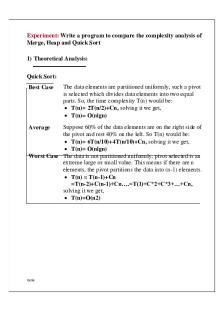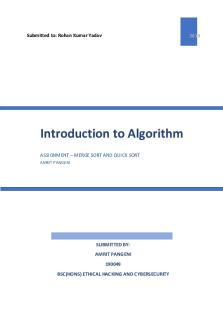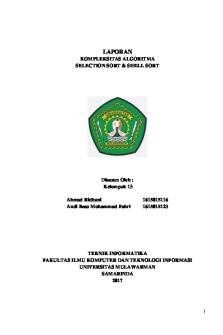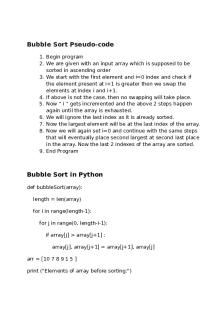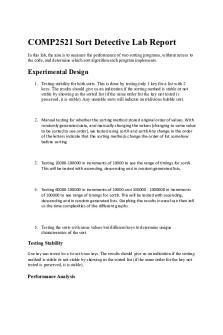Merge Sort, Heap Sort and Quick Sort time complexity analysis with program PDF

| Title | Merge Sort, Heap Sort and Quick Sort time complexity analysis with program |
|---|---|
| Author | Kiddo KiddoReel |
| Course | Computer systems |
| Institution | City University |
| Pages | 9 |
| File Size | 349.1 KB |
| File Type | |
| Total Downloads | 103 |
| Total Views | 153 |
Summary
The material includes brief theoretical and practical analysis of the time complexities of 3 different algorithms. You are likely to get this sort of assignments, home works in your higher studies, this assignment will help you to solve them....
Description
Experiment: Write a program to compare the complexity analysis of Merge, Heap and Quick Sort 1) Theoretical Analysis: Quick Sort: Best Case
The data elements are partitioned uniformly, such a pivot is selected which divides data elements into two equal parts. So, the time complexity T(n) would be: T(n)= 2T(n/2)+Cn, solving it we get, T(n)= O(nlgn)
Suppose 60% of the data elements are on the right side of the pivot and rest 40% on the left. So T(n) would be: T(n)= 6T(n/10)+4T(n/10)+Cn, solving it we get, T(n)= O(nlgn) Worst Case The data is not partitioned uniformly, pivot selected is an extreme large or small value. This means if there are n elements, the pivot partitions the data into (n-1) elements. T(n) = T(n-1)+Cn =T(n-2)+C(n-1)+Cn….=T(1)+C*2+C*3+…+Cn, solving it we get, T(n)=O(n2) Average
razia
Merge Sort: Base Case
Worst Case
The array is sorted in this case, merge sort divides array in two halves taking linear time to merge two halves so T(n)= O(nlgn), which is the same for its average and worst case as well. In every iteration, we divide the elements into further 2 sub elements. Leading lg n operations and for n iteration resulting in n log n operations. So T(n)= O(nlogn)
Heap Sort: Base Case
Best case occurs when all elements are equal, T(n)= Ω(n log n)
Worst and Average Case
Construct_heap (A, n) :- nlgn for(i=0;i...
Similar Free PDFs
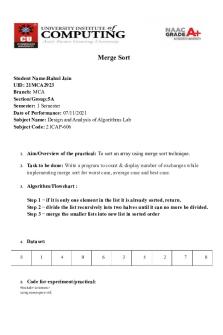
Program for Merge Sort
- 6 Pages
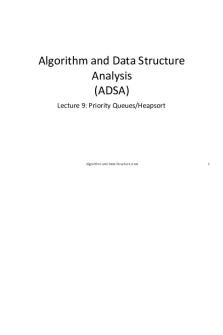
Heap Sort Priority Queues 1
- 17 Pages

INSERTION SORT
- 12 Pages
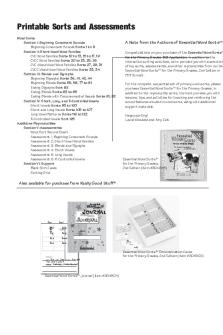
Word Sort examples
- 81 Pages

Shell Sort (Metode Shell
- 56 Pages
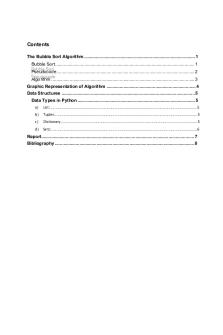
Bubble Sort Algorithm
- 10 Pages
Popular Institutions
- Tinajero National High School - Annex
- Politeknik Caltex Riau
- Yokohama City University
- SGT University
- University of Al-Qadisiyah
- Divine Word College of Vigan
- Techniek College Rotterdam
- Universidade de Santiago
- Universiti Teknologi MARA Cawangan Johor Kampus Pasir Gudang
- Poltekkes Kemenkes Yogyakarta
- Baguio City National High School
- Colegio san marcos
- preparatoria uno
- Centro de Bachillerato Tecnológico Industrial y de Servicios No. 107
- Dalian Maritime University
- Quang Trung Secondary School
- Colegio Tecnológico en Informática
- Corporación Regional de Educación Superior
- Grupo CEDVA
- Dar Al Uloom University
- Centro de Estudios Preuniversitarios de la Universidad Nacional de Ingeniería
- 上智大学
- Aakash International School, Nuna Majara
- San Felipe Neri Catholic School
- Kang Chiao International School - New Taipei City
- Misamis Occidental National High School
- Institución Educativa Escuela Normal Juan Ladrilleros
- Kolehiyo ng Pantukan
- Batanes State College
- Instituto Continental
- Sekolah Menengah Kejuruan Kesehatan Kaltara (Tarakan)
- Colegio de La Inmaculada Concepcion - Cebu
